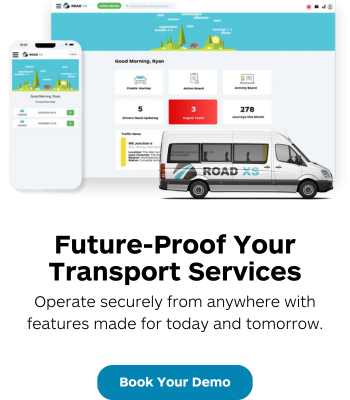In today’s fast-paced transport environment, the efficiency of operations can significantly impact the success of an organisation and the quality of their services provided. This is particularly true for transport management, where traditional paper-based activities and spreadsheets can lead to inefficiencies and wasted time.
Cloud software solutions, such as Road XS, offer a modern alternative that can streamline operations and improve productivity.
This article delves into the time wasted on paper-based and spreadsheet-based activities in transport management and compares it to the efficiencies gained by using a cloud-based solution like Road XS.
The Inefficiencies of Paper-Based Activities and Spreadsheets
In the realm of transport management, many organisations still rely heavily on paper-based systems and spreadsheets. While these traditional methods have been the backbone of operations for decades, they come with inherent inefficiencies that can significantly hinder productivity.
Here we examine issues such as time-consuming data entry, difficulties in data retrieval, limited collaboration capabilities, and ineffective reporting and analysis.
Time-Consuming Data Entry
One of the primary drawbacks of using paper-based systems and spreadsheets is the time required for data entry. Staff must manually enter data, which is not only time-consuming but also prone to errors.
A study by the Aberdeen Group found that data entry errors can lead to significant inefficiencies, with organisations spending an average of 15% of their time correcting these mistakes.
Difficulty in Data Retrieval
Retrieving data from paper records or spreadsheets can be a cumbersome process. Paper records may be stored in filing cabinets, requiring physical effort to locate and access. Similarly, spreadsheets, while digital, can become unwieldy as the volume of data grows.
According to a report by IDC, employees spend an average of 2.5 hours per day searching for information, which can be significantly reduced with an efficient digital system.
Limited Collaboration
Collaboration is another area where traditional methods fall short. Paper records can only be accessed by one person at a time, and while spreadsheets can be shared, they do not offer real-time collaboration features. This can lead to version control issues and duplicated efforts.
Research by McKinsey & Company indicates that improving collaboration through digital tools can increase productivity by up to 25%.
Ineffective Reporting and Analysis
Generating reports and analysing data from paper records or spreadsheets is not only time-consuming but also less effective. The manual nature of these tasks can result in outdated or inaccurate reports.
According to Gartner, organizations that adopt automated reporting tools see a 70% reduction in the time required to generate reports, leading to more timely and informed decision-making.
The Advantages of Using a Cloud Software

In an era where digital transformation is key to operational success, cloud software solutions like Road XS stand out as powerful tools for transport management.
Unlike traditional paper-based and spreadsheet systems, cloud-based platforms offer a host of advantages that streamline operations, enhance efficiency, and foster better collaboration.
Streamlined Data Entry and Management
Road XS simplifies data entry through automated processes and intuitive interfaces. This reduces the time spent on manual data entry and minimises errors. Automated data validation ensures that the information entered is accurate, which can significantly reduce the time spent correcting mistakes.
Efficient Data Retrieval
With Road XS, data is stored in a centralised, cloud-based system, making it easily accessible from anywhere at any time. Advanced search and filtering capabilities allow users to quickly locate the information they need, reducing the time spent on data retrieval. This leads to more efficient operations and allows employees to focus on more value-added tasks.
Enhanced Collaboration
Road XS offers robust collaboration features, enabling multiple users to work on the same data simultaneously. Real-time updates ensure that everyone is working with the most current information, reducing the risk of version control issues. This fosters better teamwork and coordination, leading to improved productivity and faster decision-making. If a journey gets cancelled – no problem, the driver is notificed and there’s no need to reprint the weekly journey sheet. Everything happens in real-time.
Advanced Reporting and Analytics
The software provides powerful reporting and analytics tools that allow users to generate detailed reports with just a few clicks. Customisable dashboards and automated report generation save time and provide valuable insights into transport operations. This enables organisations to make data-driven decisions and optimise their transport services.
Case Study: Road XS Implementation

The transition from traditional transport management methods to cloud-based solutions can bring about significant operational improvements. To illustrate these benefits, here we present a case study of a mid-sized community transport organisation that implemented Road XS.
Faced with inefficiencies in their paper-based and spreadsheet-based systems, the organisation sought a more efficient solution. This case study explores the challenges they faced, the implementation process of Road XS, and the remarkable results they achieved in terms of reduced data entry time, improved data retrieval, enhanced collaboration, and efficient reporting.
Background
A mid-sized community transport organisation faced challenges with their paper-based and spreadsheet-based systems. They experienced frequent data entry errors, difficulty in retrieving information, and inefficiencies in reporting. These issues led to wasted time and hindered their ability to provide timely and efficient transport services.
Implementation
The organisation decided to implement Road XS to address these challenges. The software was integrated into their operations, and employees received training on how to use the new system.
Results
After implementing Road XS, the organisation experienced significant improvements in efficiency:
- Reduced Data Entry Time: Automated processes cut data entry time by 92%, allowing employees to focus on more critical tasks.
- Improved Data Retrieval: The time spent searching for information was reduced by 99%, enabling faster response times and better customer service.
- Enhanced Collaboration: Real-time collaboration features improved teamwork and reduced duplicated efforts, leading to a 84% increase in productivity.
- Efficient Reporting: Automated reporting tools decreased the time required to generate reports by 97%, providing more timely insights for decision-making.
Key Recommendations

Transitioning from traditional transport management methods to a cloud-based solution like Road XS can yield substantial efficiency gains. However, the success of this transition hinges on careful planning and execution.
This section offers key recommendations for organisations considering this shift, including assessing current processes, evaluating suitable cloud software solutions, implementing the new system with thorough training, and continuously monitoring and optimising its use.
By following these steps, organisations can ensure a smooth transition and maximise the benefits of their new transport management solution.
Assess Current Processes
Organisations should begin by assessing their current processes to identify areas where inefficiencies exist. This involves evaluating the time spent on data entry, retrieval, collaboration, and reporting.
Evaluate Cloud Software Solutions
Once inefficiencies are identified, organisations should evaluate cloud software solutions like Road XS to determine which features align with their needs. Key considerations should include ease of use, integration capabilities, and the availability of support and training.
Implement and Train
A successful implementation requires careful planning and employee training. Organisations should develop a detailed implementation plan and provide comprehensive training to ensure a smooth transition to the new system.
Monitor and Optimise
After implementation, organisations should look to continuously monitor the system’s performance and gather feedback from users. This allows for ongoing optimization and ensures that the software continues to meet the organisation’s needs.
By following these recommendations, organisations can effectively transition from paper-based and spreadsheet-based systems to a cloud-based solution, leading to significant improvements in efficiency and productivity.
Conclusion
The transition from paper-based activities and spreadsheets to a cloud-based solution like Road XS can lead to substantial time savings and efficiency gains in transport management.
By streamlining data entry, enhancing collaboration, and providing advanced reporting tools, Road XS enables organisations to optimise their operations and provide better transport services. The benefits of implementing such a solution can be transformative, leading to improved productivity and more efficient use of resources.



